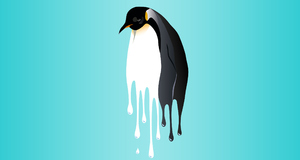From Earth Common Journal VOL. 3 NO. 1One World, One Ocean, One MissionProjects and InitiativesIn its mission to save the ocean, One World One Ocean has undertaken diverse projects and initiatives. One highly successful initiative is Surviving in a Changing Arctic, which produced the visually stunning IMAX film To the Arctic and its companion book with photographs by Florian Schulz, an award-winning nature photographer (OWOO, 2013, To the Arctic.). The film follows one year in the life of arctic wildlife including caribou, walruses and polar bears to highlight the consequences that climate change is rapidly bringing to this region that is warming twice as quickly as anywhere else (G. MacGillivray, as cited in Loose, 2012, How Is It Changing). At first glance, it may not be obvious what the Arctic region has to do with risks to the ocean. A clear connection does exist, however. The problem is complex, but One World One Ocean summarizes it this way: “As glaciers melt, fresh water enters the ocean, making the cold, deep water warmer, less salty and less able to hold oxygen and carbon dioxide. As the current is altered, it will have unknown effects on everything from sea life to our climate” (2013, Why the Arctic?, Ocean Engine). To the Arctic’s success can be measured in several ways. First, its box office receipts surpassed $11 million in November 2012 (Ocean Minds, 2012, para. 1). Second, the film has received the recognition of others in the documentary industry, including the Giant Screen Cinema Association, which awarded the film two top honours in 2012: Best Film Short Subject and Best Film for Lifelong Learning (Ocean Minds, 2012, para. 2). Third, and most important, the film has motivated viewers to action. In an independent survey, respondents noted the following after seeing the film (Reckas, 2012, para. 5-7):
GoalsWhile One World One Ocean has had many successes to date and is proud of its accomplishments, the organization understands that saving the world’s oceans is an ongoing process. “We don’t think one film alone will change public perception of the ocean. We are committed to a long-term release of films and multi-media programming that will build awareness, and continue reminding people that a healthy ocean is essential to us all” (OWOO, 2013, Why We’re Different, para. 2). Given that essentiality, what are One World One Ocean’s specific goals to save the ocean? The organization has three main goals. The first is to encourage consumers to buy sustainable seafood products (OWOO, 2013, Goals, #1). Many of the problems the ocean faces are the result of overfishing and species collapse, where a species “has fallen to 10 per cent of its highest known numbers” (Layton, 2013, para. 2). If we want to preserve fish populations for future generations, a sustainable seafood industry is critical. It is not necessary to stop eating fish and seafood; instead, “we can create a true shift to sustainable seafood…. [if we] make the right choices at the grocery store and at restaurants” (OWOO, 2013, Goals, #1). One World One Ocean believes this goal is achievable through awareness raising and helping people understand the environmental implications of what they choose to eat. A major OWOO initiative to meet this goal is its GO Fish! Making Seafood Month Sustainable campaign, which encourages seafood consumers to take “simple actions.... to celebrate seafood in a way that’s healthy for the ocean” (OWOO, 2013, Go Fish!, para. 1). One tool the organization uses is the Know Your Seafood infographic (OWOO, 2013, Goals, #1) which includes a red list and a green list of types of fish and seafood to buy and suggested retailers that sell sustainable seafood. The second goal is to reduce plastic pollution (OWOO, 2013, Goals, #2). Plastics are as big a problem in the ocean as they are on land, perhaps even more so. According to the Algalita Marine Research Foundation, plastic in the ocean causes many negative effects: Fish and seabirds mistake plastic for food. Plastic debris release chemical additives and plasticizers into the ocean. Plastic also adsorbs hydrophobic pollutants, like PCBs, and pesticides like DDT. These pollutants bioaccumulate in the tissues of marine organisms, biomagnify up the food chain, and find their way into the foods we eat. (n.d., p. 2) In addition, sea animals can get tangled in the debris and end up injured or dying of strangulation. For all these reasons, we must reduce the plastic pollution that gets into the ocean. While this goal is challenging, it is not impossible. Individuals can make more environmentally responsible decisions about the amount of packaging on items they purchase and about how they carry and transport personal items. As an organization, One World One Ocean helps meet this goal by providing “tools for people to use in their community to create public awareness of plastic waste” (OWOO, 2013, Goals, #2), such as the infographic Plastic Breakdown which includes information on how plastics harm the ocean, how much plastic is in the ocean and how we can help reduce new plastic pollution in the future. One World One Ocean’s third goal is to expand protected areas to 10% of our oceans from the currently less than 2% (OWOO, 2013, Goals, #3). “Protected” refers to legal protections put in place for a specified area of the ocean that “regulates what can be done there in terms of fishing, boating, and other forms of access” (OWOO, 2013, Goals, #3). This protection can take the form of national marine sanctuaries, marine protected areas, or world heritage marine sites depending on the location and the degree of protection granted (OWOO, 2013, Goals, #3). Studies show “rebounds in species diversity and population levels within five to ten years after gaining protections, actually boosting things like fishing and ecotourism”(OWOO, 2013, Goals, #3). Strides towards meeting this goal have already taken place. For example, the Convention on Biological Diversity, signed in 2012 by 193 countries, passed a declaration that “10 per cent of coastal and marine areas [will be] conserved through effectively and equitably managed, ecologically representative and well-connected systems of protected areas” by 2020 (Target 11). What We Can DoOne World One Ocean’s goals are grand, hopeful goals that cover a lot of water, but they are realistic, and we can help the organization meet those goals. We can buy sustainable seafood from responsible retailers. We can reduce the plastics we purchase and recycle those that we do use so that they do not end up in the ocean. We can encourage governments and other organizations to work toward increasing the areas of the ocean that are protected and vote for officials who care about the environment as much as we do. We can spread the word to friends and family about the issues facing the ocean and explain why they should follow suit and undertake these same actions. One World One Ocean is a leader in the area of ocean conservation, but for their work to succeed we must follow. ConclusionThrough its initiatives, One World One Ocean is a strong voice for change in the ways that humans interact with the ocean. The organization has demonstrated what needs to be done to protect the world’s major water source and provided ideas about how we can do it. To date, the organization has inspired audiences and led the way when it comes to protecting the ocean. It has begun successful media-driven programs based on a central idea: “A critical part of our approach will be showcasing stories of hope and success…. We want to show the world that we can do this. We can save the ocean” (S. MacGillivary, as cited in OWOO, 2011). And indeed we must save it because “everyone, everywhere depends on a healthy sea” (OWOO, 2013, Why the Ocean?, para. 1). ReferencesAlgalita Marine Research Foundation. (n.d.). Plastic debris from rivers to sea. Retrieved from http://www.algalita.org/pdf/PLASTIC%20DEBRIS%20ENGLISH.pdf Convention on Biological Diversity. (n.d.). Target 11 - Technical rationale extended. Retrieved from http://www.cbd.int/sp/targets/rationale/target-11/ IMAX. (n.d.) IMAX: To the Arctic. Retrieved from http://www.imax.com/tothearctic/site.html# Layton, Julie. (2013). Endangered species: Why would there be no more fish in 40 years? Animal Discovery. Retrieved from http://animal.discovery.com/endangered- species/no-more-fish.htm Loose, T. (2012, April 25). Interview with Greg and Shaun MacGillivray. Coast Magazine. Retrieved from http://www.coastmagazine.com/articles/macgillivray-2153--.html MacGillivray Freeman Films. (2010). An education legacy. Retrieved from http://www.macgillivrayfreemanfilms.com/site/our-educational-outreach/an- education-legacy.html MacGillivray Freeman Films. (2010). Educational impact. Retrieved from http://www.macgillivrayfreemanfilms.com/site/our-educational- outreach/educational-impact.html MacGillivray Freeman Films. (2010). One World One Ocean campaign. Retrieved from http://www.macgillivrayfreemanfilms.com/site/our-company/company- profile/one-world-one-ocean-campaign.html MacGillivray Freeman Films. (2010). Our history. Retrieved from http://www.macgillivrayfreemanfilms.com/site/our-company/company- profile/our-history.html MacGillivray Freeman Films. (2010). Our mission. Retrieved from http://www.macgillivrayfreemanfilms.com/site/our-company/company- profile/our-mission.html Marine Bio. (n.d.). Marine conservation organizations. Retrieved from http://marinebio.org/oceans/conservation/organizations.asp National Oceanic and Atmospheric Administration. (2011, May 16). New analysis: 75% of coral reefs under threat. Retrieved from http://coralreef.noaa.gov/aboutcrcp/news/featuredstories/feb11/cu_threat/ Ocean Minds. (2012, November 26). 3D film To The Arctic passes $10 million milestone worldwide. Retrieved from http://www.oceanminds.com/3d-film-to-the-arctic- passes-10-million-milestone-worldwide/ One World One Ocean. (2011, October 12). MacGillivray Freeman Films director launches One World One Ocean campaign [Press Release]. Retrieved from http://www.oneworldoneocean.com/press_releases/entry/macgillivray-freeman- films-director-launches-one-world-one-ocean-campaign#.UYHMc7WsiSo One World One Ocean. (2012). Mission. Retrieved from http://www.oneworldoneocean.com/ One World One Ocean. (Oct. 5, 2012). MacGillivray Freeman’s One World One Ocean campaign voted Best Digital Interactive Campaign at the 2012 Blue Ocean Film Festival [Press Release]. Retrieved from http://www.oneworldoneocean.com/media/press/OWOO_Wins_Best_Campaign_at_BLUE_10_05_12.pdf One World One Ocean. (2013). Goals. Retrieved from http://www.oneworldoneocean.com/pages/our-goals#.UX19DLWsiSo One World One Ocean. (2013). Go fish! Retrieved from http://www.oneworldoneocean.com/initiatives/gofish One World One Ocean. (2013). To the Arctic. Retrieved from http://www.oneworldoneocean.com/content/to_the_arctic One World One Ocean. (2013). Why the Arctic? Retrieved from http://www.oneworldoneocean.com/content/why_the_arctic One World One Ocean. (2013). Why the ocean? Retrieved from http://www.oneworldoneocean.com/pages/why-the-ocean#.UX1szLWsiSo One World One Ocean. (2013). Why we’re different. Retrieved from http://www.oneworldoneocean.com/pages/why-were-different#.UX18t7WsiSo One World One Ocean Foundation. (2013). Who we are. Retrieved from http://www.oneworldoneoceanfoundation.org/about-us/who-we-are.html Reckas, T. (2012, May 9). To The Arctic moves the needle [Web blog post]. Retrieved from http://www.oneworldoneocean.com/blog/entry/to-the-arctic-moves-the- needle#.UYHU0bWsiSo Scientific American (2013). What causes ocean dead zones? Retrieved from http://www.scientificamerican.com/article.cfm?id=ocean-dead-zones Tech-FAQ. (2012). IMAX. Retrieved from http://www.tech-faq.com/imax.html United States Department of State. (2013, Feb. 20). More than words: Using video to inspire change. Retrieved from http://iipdigital.usembassy.gov/st/english/pamphlet/2013/02/20130212142452.ht ml#axzz2R7zYaTVX Video Volunteers. (n.d.). Video and social change. Retrieved from http://www.videovolunteers.org/impact/video-and-social-change/ Wilkinson, C. (2008). Executive summary. In Global Coral Reef Monitoring Network, Status of coral reefs of the world: 2008 (pp. 5-19). Retrieved from http://www.reefbase.org/download/gcrmn_download.aspx?type=10&docid=13312 Suggested Reading from Inquiries Journal
Inquiries Journal provides undergraduate and graduate students around the world a platform for the wide dissemination of academic work over a range of core disciplines. Representing the work of students from hundreds of institutions around the globe, Inquiries Journal's large database of academic articles is completely free. Learn more | Blog | Submit Latest in Environmental Studies |

















